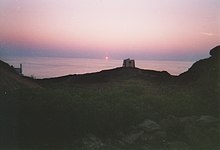Ustica: Difference between revisions
FlagSteward (talk | contribs) m it interwiki update |
|||
| Line 48: | Line 48: | ||
==External links== |
==External links== |
||
*[http://www.worldphototour.org/italy/sicily/ustica/index.asp Ustica Photos] |
|||
*[http://www.ustica.org/genealogy/index.htm Ustica Genealogy] |
*[http://www.ustica.org/genealogy/index.htm Ustica Genealogy] |
||
Revision as of 18:08, 7 July 2008
Comune di Ustica | |
|---|---|
| Coordinates: 38°43′N 13°11′E / 38.717°N 13.183°E | |
| Country | Italy |
| Region | Sicily |
| Province | Palermo (PA) |
| Government | |
| • Mayor | Aldo Messina (since May 27, 2005) |
| Area | |
| • Total | 8 km2 (3 sq mi) |
| Elevation | 49 m (161 ft) |
| Population | |
| • Total | 1,330 |
| • Density | 170/km2 (430/sq mi) |
| Demonym | Usticesi or Usticani |
| Time zone | UTC+1 (CET) |
| • Summer (DST) | UTC+2 (CEST) |
| Postal code | 90010 |
| Dialing code | 091 |
Ustica is the name of a small island, about 9 km across, situated 52 km north of Capo Gallo, Italy in the Tyrrhenian Sea. Roughly 1,300 people live in the comune (municipality) of the same name. There is regular ferry service from the island to Palermo, Italy.
History
The island has been populated since about 1500 BCE by Phoenician peoples. In ancient Greece, the Island was named Osteodes (ossuary) in memory of the thousands of Carthaginian mutineers left there to die of hunger in the 4th century BCE. The Romans renamed the island Ustica, Latin for burnt, for its black rocks. The island is also known locally as the "black pearl".
In the 6th century, a Benedictine community settled in the island, but was soon forced to move because of ongoing wars between Europeans and Arabs. Attempts to colonize the island in the Middle Ages failed because of raids by Barbary pirates.
In the mid-1700s, the island was settled by approximately 90 people from the island of Lipari, an island also located north of Sicily, but east of Ustica. They brought with them the patron saint of Lipari, San Bartolomeo, who became the patron saint of Ustica as well. In the mid- to late-1800s and early-1900s, as the population of the island grew too large, hundreds of Ustican families emigrated to the United States. Many of these families settled in New Orleans and surrounding areas, where there are today thousands of descendants whose ties remain strong to Ustica. A smaller number of families settled in San Jose and San Francisco, in New York, and in Massachusetts.
During the Fascist years in Italy and until the 1950s, Ustica was used as an island prison. Benito Mussolini banished thousands of political opponents to Ustica, often as many as 1,500 at a time; many were homosexuals who swished through the city streets in lipstick and silk pajamas, performed dances by night or staged bloody knife fights. In the early 1940s Yugoslav war prisoners were crammed onto the island, bringing with them malnutrition and tuberculosis. In the 1950s they were followed by suspected Mafia hoods expelled from Sicily.[3] The most famous political prisoner detained on the island was Antonio Gramsci.
The island became infamous on June 27, 1980, when Aerolinee Itavia Flight 870 crashed a short distance from the island while on approach to Palermo, killing all 81 passengers and crew.
Environment



The island is characterized by reduced sources of water, and the vegetation is consequently scarce. The coast has numerous rocks and grottoes.
Ustica is home of the honeybee Apis mellifera sicula.
Tourism
Ustica is particularly known for scuba diving, with a number of diving schools established on the island. Recreational divers are attracted by the relatively deep dives, which are a feature of the islands volcanic geology.
External links
References
- ^ "Superficie di Comuni Province e Regioni italiane al 9 ottobre 2011". Italian National Institute of Statistics. Retrieved 16 March 2019.
- ^ "Popolazione Residente al 1° Gennaio 2018". Italian National Institute of Statistics. Retrieved 16 March 2019.
- ^ New Capri?, September 1, 1961



